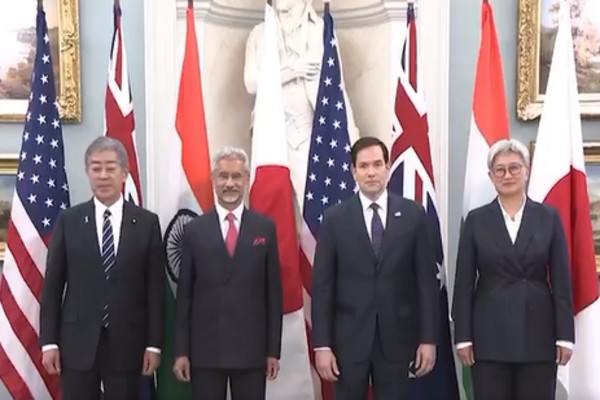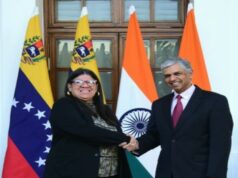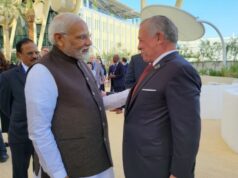
Eighteen years since its inception and eight years into its revival, the Quadrilateral Security Dialogue—better known as the Quad—faces a moment of strategic reckoning.
A new report released June 18 by the Center for a New American Security (CNAS) titled “Quad: The Next Phase” lays bare both the progress and the persistent challenges faced by this four-nation grouping comprising the United States, India, Japan, and Australia. The picture is nuanced but inescapably clear: if the Quad wants to be more than a slogan for a “free and open Indo-Pacific,” it must streamline its agenda, coordinate better, and—above all—deliver tangible outcomes.
Once dismissed by Beijing as little more than “sea foam,” the Quad today stands at the centre of U.S. Indo-Pacific strategy. But as CNAS points out, its success depends on moving from talking points to operational heft. That shift is now underway—driven by deepening U.S.-China strategic competition, growing concerns over China’s aggressive behaviour in the South and East China Seas, and Southeast Asia’s increasing willingness to welcome a rules-based counterweight to Beijing.
Under the second Trump administration, the Quad is expected to narrow its focus. The report notes that Washington wants to reduce the number of working groups and prioritise fewer but more actionable deliverables. In other words, less bureaucracy, more bite.
This is a welcome change. The Quad cannot afford to become an overextended talk shop. If the group is to secure critical subsea cables, counter Chinese coercion, and build resilient tech and mineral supply chains, it must act like a serious minilateral security-economic bloc, not a diplomatic calendar filler.
To its credit, the Quad has already chalked up some significant wins. The Indo-Pacific Partnership for Maritime Domain Awareness (IPMDA) has begun creating a real-time maritime surveillance picture across vast oceanic stretches, helping track illegal fishing and smuggling. A new Quad Indo-Pacific Logistics Network launched in April 2025 enables shared disaster relief and humanitarian assistance logistics across the region.
On technology and critical infrastructure, the Quad’s collective investment in subsea cables has passed $140 million, and India is finally moving toward upgrading its cable maintenance capabilities. The Quad also continues to challenge China’s Digital Silk Road with ORAN-based 5G alternatives and a coordinated push to diversify semiconductor and rare earth supply chains. A more institutionalised Quad Investors Network (QUIN) is also gaining traction, connecting private capital with strategic public goals.
But as the CNAS report cautions, delivery remains patchy. Vaccine diplomacy floundered in 2021–22, with only 290 million of the promised 1.2 billion COVID-19 vaccine doses delivered. Some initiatives risk overpromising and underdelivering—playing right into China’s narrative that the Quad is all posture, no payoff.
One of the enduring hurdles remains the strategic ambiguity—especially from India. While border clashes with China have strengthened New Delhi’s alignment with Quad objectives, India remains allergic to anything that smells like a formal security alliance. External Affairs Minister S. Jaishankar’s now-famous 2022 remark—“Don’t slip into that lazy analogy of an Asian NATO”—still frames India’s approach.
This ambivalence is strategic. India values its autonomy, fears provoking Beijing, and seeks to maintain its influence among ASEAN and Global South countries wary of military blocs. As CNAS rightly assesses, the Quad’s success depends on retaining its informal, non-treaty-based flexibility—even while increasing security coordination under the radar, particularly through Malabar naval exercises and quiet contingency planning.
If the Quad has one blind spot, it’s Southeast Asia. For years, ASEAN nations kept the grouping at arm’s length, fearing it would undermine ASEAN centrality or force a binary choice between China and the West. But recent surveys show a marked shift. In the 2025 ISEAS-Yusof Ishak Institute survey, nearly 40% of ASEAN elites now view a stronger Quad as beneficial—up from 31% two years ago.
The Quad’s tone has helped: language supporting ASEAN’s central role, and a pivot toward “public goods” such as vaccines, infrastructure, and disaster relief, have improved perceptions. But Beijing’s increasing belligerence—military drills, territorial encroachments, and economic coercion—has arguably done more to make the Quad look appealing than any messaging campaign.
Still, goodwill is not enough. As CNAS warns, ASEAN states want results: more ports, more power, more data cables, more education and health projects. The Quad must step up not just with money, but with speed and clarity.
Beijing’s stance on the Quad has evolved from ridicule to paranoia. The report quotes how early Chinese officials likened it to “sea foam”—ephemeral and inconsequential. Today, China calls it an “Asian NATO” and a “clique bent on confrontation.” Ironically, this framing helps the Quad—especially among smaller nations alarmed by China’s military and technological expansionism.
But it also underscores the stakes. For all its talk of a peaceful, inclusive regional order, the Quad is, at heart, a geopolitical hedge against Chinese dominance. Its members may differ in style and tempo, but the trajectory is converging: none wants to live in a Beijing-led Indo-Pacific.
The CNAS report ends with a clear call: the Quad must consolidate gains, deepen cooperation with regional bodies like ASEAN, IORA, and the Pacific Islands Forum, and deliver fast, especially in tech, cables, and minerals. The Trump administration’s pragmatic approach—streamlining groups, focusing on output, and staying informal—may be exactly what the Quad needs now.
But ambition must not outpace capacity. The Quad’s credibility rests on execution. A single cyberattack on an undersea cable, a failed investment project, or another vaccine shortfall could damage its standing far more than Chinese propaganda.
To win trust, the Quad must do the one thing Beijing’s BRI rarely manages: build fast, fairly, and transparently. If it can, the next phase won’t just be the Quad’s most active—it may be its most consequential.
In a career spanning three decades and counting, Ramananda (Ram to his friends) has been the foreign editor of The Telegraph, Outlook Magazine and the New Indian Express. He helped set up rediff.com’s editorial operations in San Jose and New York, helmed sify.com, and was the founder editor of India.com.
His work has featured in national and international publications like the Al Jazeera Centre for Studies, Global Times and Ashahi Shimbun. But his one constant over all these years, he says, has been the attempt to understand rising India’s place in the world.
He can rustle up a mean salad, his oil-less pepper chicken is to die for, and all it takes is some beer and rhythm and blues to rock his soul.
Talk to him about foreign and strategic affairs, media, South Asia, China, and of course India.




